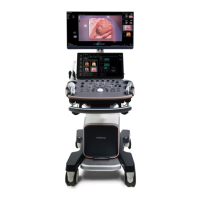5-110 Image Optimization
5.15.7 Exiting the Stress Echo Feature
To exit the Stress Echo feature:
Tap [End Exam] on the control panel or click [End SE exam] on the screen.
5.15.8 Measurement and Report
Suspend the stress echo exam by selecting [Suspend Exam] on the soft menu. Press the measurement
related keys or buttons to enter cardiology measurement. For details, see the [Advanced Volume].
Reports contain the entered indication, if any, and also any entered comments that are specific to the
report. You can include or exclude data from specific phase(s). You can preview and print the report for
the currently selected mode. You can also enable colored report printing in Maintenance.
Entering Indications or Comments for the Reports
You can enter an indication for display in Stress Echo reports.
To enter an indication:
1. Press <Report> on the control panel to open the report.
2. Use the keyboard to enter text in the Indication dialog box and then click [OK].
5.16 Tissue Tracking Quantitative Analysis
CAUTION:
Tissue Tracking Quantitative Analysis images are provided for reference only,
not for confirming diagnoses.
Apart from TDI imaging function, the system also provides tissue tracking QA function for myocardial
movement evaluation.
By tissue tracking QA function, the ultrasound system will scan each pixel position by frame within the
cardiac cycle, and then use region matching method and auto-correlation searching method to trace
each spot and calculate the movement, so as to determine myocardial motion in a more quantitative
way.
Tissue tracking quantitative analysis is an option.
5.16.1 Basic Procedures for Tissue Tracking QA
1. Open a saved B mode cardiac cine file (a cin. format file which contains more than 1 cardiac cycle
(with 2 R waves) and ECG signal).
2. Tap [TT QA] on the touch screen:
a) You can determine the image of interest by previewing the image
b) To find the image of interest, tap [Cycle] on the touch screen to select.
3. Select the corresponding section name on the soft menu and locate one frame image with good
image effect by cine play. Use the cursor to set the reference point:
Long axis section: use the “3-point” method or “Manual” method to set
Short axis section: enter multiple points (at least 6 points) using the cursor manually to set.
4. After reference points are set, the system will display the boundary of the endocardium and
epicardium. Adjust the thickness if necessary.
If the traced result is poor, tap [Reload] on the touch screen to re-trace the reference points, or make
fine adjustments to the points using the cursor.
If the cycles are not adequate to provide the information, switch to another cycle to trace.
5. Tap [Start Tracking] on the touch screen to start the tracking function. Adjust the parameters if
necessary.

